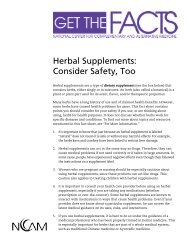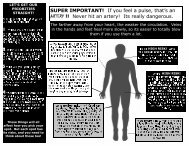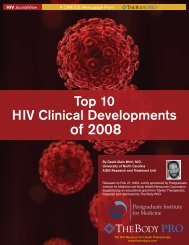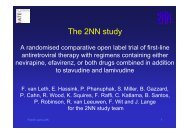Hepatitis C: New Treatments in the Pipeline - CD8 T cells - The Body
Hepatitis C: New Treatments in the Pipeline - CD8 T cells - The Body
Hepatitis C: New Treatments in the Pipeline - CD8 T cells - The Body
You also want an ePaper? Increase the reach of your titles
YUMPU automatically turns print PDFs into web optimized ePapers that Google loves.
Introduction<br />
Prevent<strong>in</strong>g new <strong>in</strong>fections will not impact <strong>the</strong> predicted wave of morbidity and mortality<br />
from persons already <strong>in</strong>fected.<br />
While better and more affordable treatments are eagerly anticipated, much can be<br />
accomplished <strong>in</strong> <strong>the</strong> <strong>in</strong>terim.<br />
Affected countries must face <strong>the</strong> dilemmas at hand and give careful consideration to<br />
<strong>the</strong> array of available options for address<strong>in</strong>g and m<strong>in</strong>imiz<strong>in</strong>g <strong>the</strong> com<strong>in</strong>g wave of HCVrelated<br />
liver disease.<br />
Current strategies to reduce <strong>the</strong> long-term sequelae of chronic HCV <strong>in</strong>fection <strong>in</strong>clude<br />
identify<strong>in</strong>g <strong>in</strong>fected persons by test<strong>in</strong>g those at high risk and offer<strong>in</strong>g counsel<strong>in</strong>g,<br />
medical evaluation and treatment.<br />
—J.F. Perz and M.J. Alter<br />
Journal of Hepatology<br />
<strong>Hepatitis</strong> C virus (HCV) is a serious global health problem. Accord<strong>in</strong>g to <strong>the</strong> World Health<br />
Organization (WHO), which describes HCV as a “viral time bomb,” 130 million people<br />
have chronic hepatitis C, and 3 to 4 million more become <strong>in</strong>fected each year (WHO 2007).<br />
If untreated, or unresponsive to treatment, chronic HCV leads to cirrhosis <strong>in</strong> 20–30% of<br />
people. Each year, ~4% of people with hepatitis C-associated cirrhosis develop liver cancer,<br />
and ~6% will experience liver failure (Di Bisceglie 2000). WHO estimates that up to 75% of<br />
liver cancer and ~65% of liver transplants occurr<strong>in</strong>g <strong>in</strong> <strong>the</strong> developed world are attributable<br />
to chronic HCV <strong>in</strong>fection (WHO 2007).<br />
<strong>The</strong> current standard of care for HCV, pegylated <strong>in</strong>terferon and ribavir<strong>in</strong>, is not effective for<br />
approximately half of those who undergo it, and <strong>the</strong> side effects are often debilitat<strong>in</strong>g.<br />
<strong>The</strong> need for new <strong>the</strong>rapies for hepatitis C virus is more urgent than ever, particularly for<br />
a grow<strong>in</strong>g population of treatment-experienced people with serious liver damage. Results<br />
from HALT-C and SLAM-C—two <strong>in</strong>terferon ma<strong>in</strong>tenance trials for people with advanced liver<br />
damage—were an unexpected disappo<strong>in</strong>tment. Both reported that ma<strong>in</strong>tenance <strong>the</strong>rapy did<br />
not reduce fibrosis progression, hepatic decompensation, or liver-related mortality, leav<strong>in</strong>g no<br />
stopgap until new drugs are available (Di Bisceglie 2007; Sherman 2008). Without advances<br />
<strong>in</strong>, and broader access to, HCV treatment, liver-related mortality is expected to rise sharply <strong>in</strong><br />
<strong>the</strong> com<strong>in</strong>g years (Davis 2003).<br />
Better HCV treatment is critical for <strong>the</strong> estimated 4 to 5 million HIV/HCV-co<strong>in</strong>fected people<br />
(Alter 2006). HIV <strong>in</strong>creases <strong>the</strong> risk for and rate of hepatitis C progression. In fact, end-stage<br />
liver disease is now <strong>the</strong> lead<strong>in</strong>g cause of non-AIDS-related death among HIV-positive people<br />
<strong>in</strong> areas where antiretroviral <strong>the</strong>rapy is available (Weber 2006).<br />
7

















